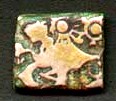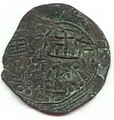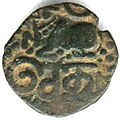Pre-modern coinage in Sri Lanka: Difference between revisions
m moved Jaffna Coinage to Tamil coinage: seems to deal with more than just coins from the Jaffna area |
mNo edit summary |
||
| Line 1: | Line 1: | ||
{{hoax}} |
|||
==The ancient period== |
==The ancient period== |
||
Most of the coins used in pre- |
Most of the coins used in pre-Christian [[Sri Lanka]] can be categorised as Punch-marked coins, Tree and Swastika coins, Elephant and Swastika coins and Lakshmi paques. |
||
===Punch-marked coins=== |
===Punch-marked coins=== |
||
Revision as of 15:00, 18 April 2007
The ancient period
Most of the coins used in pre-Christian Sri Lanka can be categorised as Punch-marked coins, Tree and Swastika coins, Elephant and Swastika coins and Lakshmi paques.
Punch-marked coins
They are referred to as punch-marked coins or eldings. Similar coins have been unearthed throughout the island. Large numbers of such coins have been found in the northern and eastern districts of Sri Lanka too but a study on regional varieties is yet to be done.
-
A punch marked coin
-
A punch marked coin
These punch marked coins are usualy in silver and have assorted combinations of symbols punched on them, Usually the reverse of the coin is blank. Stylistically these coins are similar to coins used in the Indian sub-continent during this period. A recent publication on these coins attempts to identify symbols peculiar to Sri Lanka. Some of the more popular symbols are Sun, Moon, elephant, bull, nandipada, fish and peacock. The diversity of symbols suggests that these coins have been issued by regional rulers or traders and not by a central monarchy.
Tree and Swastika coins
The Tree and Swastika coins are always cast. The tree on these coins is sometimes called a Bo-tree, a tree with religious significance to the Buddhists. However as these coins are pre- Buddhist, the tree is more likely to be a widely accepted holy tree from the region.
Elephant and Swastika coins
The older coins of this type are cast and the later ones are struck. The cast coins are much thicker that the thinner struck coins. A struck coin is illustrated below.
Lakshmi plaques
The goddess Lakshmi coins are either cast or struck.[1] The two coins illustrated below are cast. They are found in may sizes ranging from about 3 inches to half an inch. The obverse of these coins bear the image of the goddess holding lotus stalks, surmounted by two elephants pouring water. Initially these were thought to be votive offerings. but now scholars are unanimous that they were indeed coins.
-
A goddess Lakshmi coin
-
The reverse of the goddess Lakshmi coin
-
A goddess Lakshmi coin
-
The reverse of the goddess Lakshmi coin
The early period
The Bull and Fish symbols figure prominently on the coins used in northern Sri Lanka during the early period.
-
A rectangular Nandi Bull coin
-
Another rectangular Nandi Bull coin
-
A Pandyan Nandi Bull coin
-
The reverse of the Bull coin with two Pandyan fish
-
The reverse of another Pandyan Bull coin
-
A Pallava lion coin
-
The reverse of the Pallava lion coin
-
An Elephant and Fish coin
The mediaeval period
Chola coins
Gold and copper coins issued by the Chola ruler Rajaraja Chola (985-1014) are excavated from many parts of Sri Lanka. The obverse and reverse of these coins are similar to the common Dambadeniya Massa coins issued by later Kalinga and Pandya rulers of Sri Lanka. This prototype for the Dambadeniya coins uses Tamil characters on the reverse for the kings name.
-
A gold coin of Rajaraja Chola
-
The reverse of the Rajaraja Chola gold coin with a seated human figure and the king's name in Tamil
-
A copper coin of Rajaraja Chola with a Tiger besides the human figure
-
The reverse of the Rajaraja Chola copper coin with a seated human figure and the king's name in Tamil
-
A coin of Rajadhiraja Chola II with a lion surmounted by a sword
-
The reverse of the Rajadhiraja Chola II coin with his name in Devanagari
-
A silver coin of Uttama Chola with a Tiger and two fish
-
The reverse of Uttama Chola coin with his name in Devanagari
Sethu Bull coins
Several types of coins categorised as Sethu Bull coins are found in large quantities in the northern part of Sri Lanka. Three types of this series are illustrated below. The obverse of these coins have a human figure flanked by lamps and the reverse has the Nandi (bull) symbol, the legend Sethu in Tamil with a crescent moon above. The obverse is similar to the contemporary Massa coins issued by the Kalinga and Pandyan rulers of the central Sri Lankan kingdom of Dambadeniya. The reverse of the Massa coins have the image of a seated man with the ruler's name such as Vijayabahu, Nissankamalla, Parakramabahu etc in Devanagari characters.
-
A Setu coin
-
The reverse of the Setu coin
-
A Setu Bull coin
-
The reverse of the Setu Bull coin
-
A Setu Bull coin
-
The reverse of the Setu Bull coin
The late period
These coins known as 'Parakramabahu lion type' are found in large numbers in the northern and western parts of Sri Lanka. The king is Parakramabahu VI of Kotte and the coins are belived to have been issued by Chempaka Perumal (A Tamilian price called Sapumal Kumara by the Sinhalese) who ruled from Nallur for some years. Although some writers have suggested that the lion represents Sinhala dominance over the Jaffna kingdom others have pointed out that the lion is stylistically Tamilian and unmistakably so. There is no evidence that king Parakramabahu VI has ever claimed to be a Sinhalese. His Kotte fortress is described in literature as adorned with tiger faces (puli mukam) and his daughter was married to the Tamil prince Nallurutun.
As illustrated above the lion symbol was used on Jaffna coins by Pallava rulers as well. The lion on the Rajadhiraja Chola II is very simillar to the lion on the present Lion Flag of Sri Lanka. (See creation of the Lion myth of Sri Lanka for deleted information retrieved from Wikipedia archives on the lion flag)
The Dutch period
These heavy rough copper coins were struck by the Dutch East India Company to use in the Jaffna territory. They were issued in the denominations of 1 and 2 Stuivers. These coins are also referred to as 'Dutch dumps'. Coins similar to those minted in Jaffna were minted in Trincomalee, Colombo and Galle as well and they bear the letters T, C and G respectively as mint marks.
-
A Dutch stuiver struck in Jaffna with the VOC monogram of the Dutch East India Company surmounted by the letter J indicating that the coin was struck at the Jaffna mint
The modern period
LTTE Gold coin
From | Lakdiva.org
References
- ^ "1st-3rd Century AD - Lanka: Anuradhapura Period - 'Lakshmi' Plaques". Retrieved 2007-04-18.
- Codrington Ceylon Coins and Currrency
- Abhayawardena Coins of Ceylon
- Punch marked coins of Sri Lanka
- Seyone Jaffna coins
- lakdiva.org






























